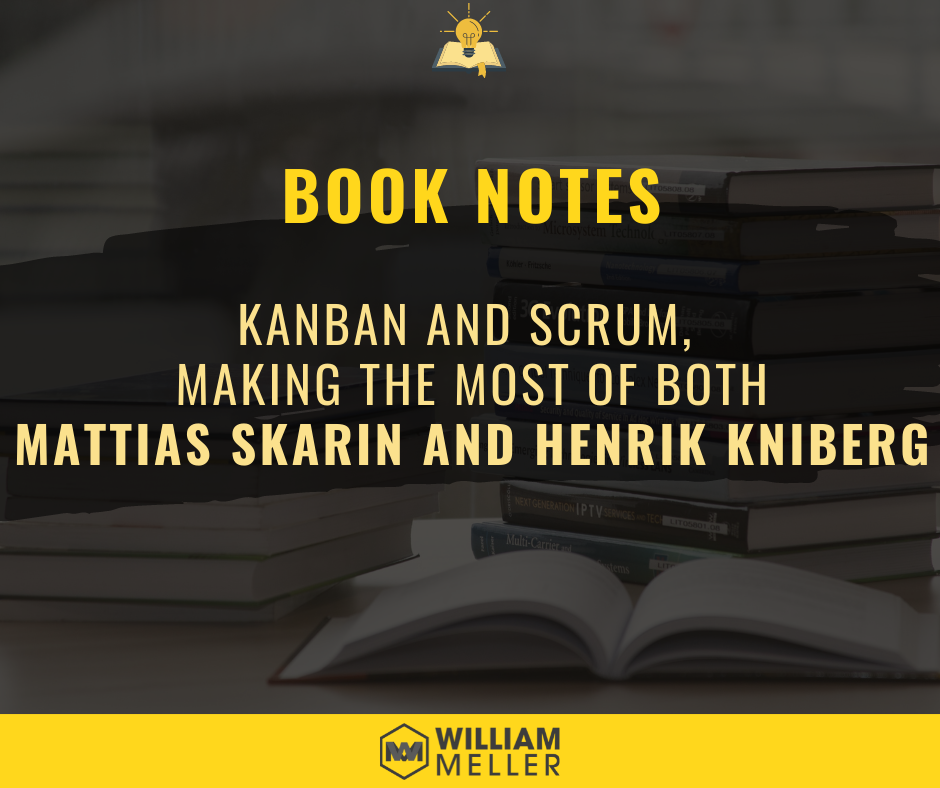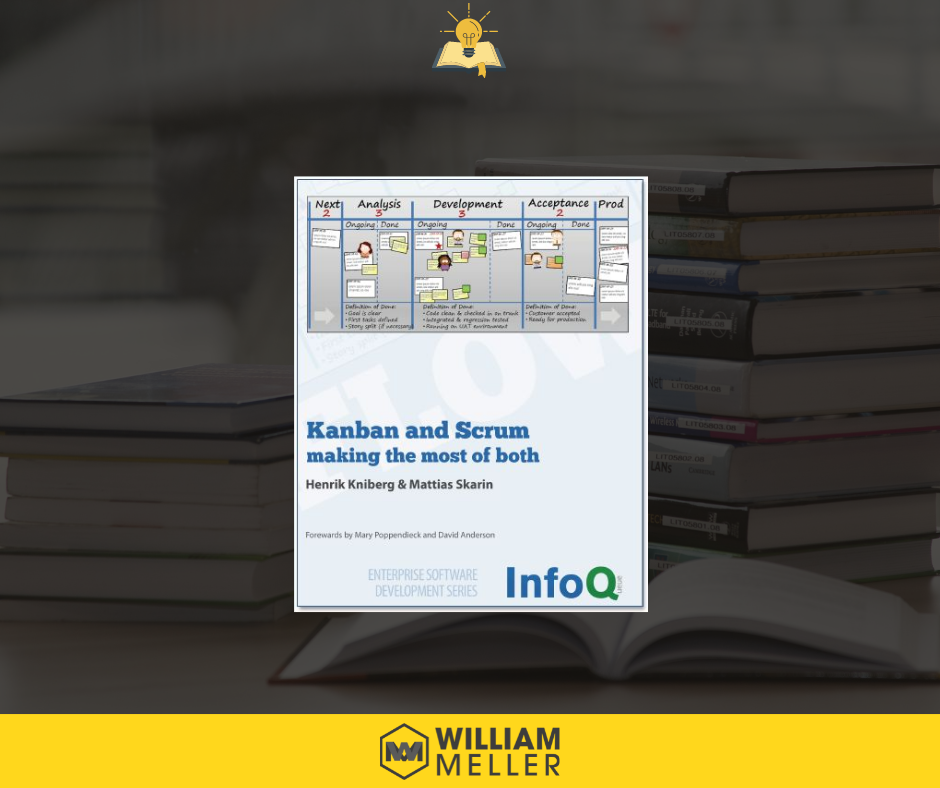
Scrum and Kanban are two flavors of Agile software development - two simple but surprisingly powerful approaches to software development.
Summary
Title: Kanban and Scrum, Making the Most of Both
Author: Mattias Skarin and Henrik Kniberg
Themes: Technology, Management, Business, Agile, Kanban, Scrum
Year: 2010
Publisher: Lulu.com
ISBN: 0557138329, 9780557138326
Pages: 120
You've probably heard of Scrum and Kanban if you're interested in agile software development.
Kanban and Scrum, Making the Most of Both is a book written by Mattias Skarin and Henrik Kniberg that provides an overview of two popular Agile development methodologies, Kanban and Scrum, and how they can be used together to optimize workflow and increase productivity.
This book aims to clear up the fog about how Kanban and Scrum can relate somehow, so you can identify how Kanban and Scrum might be useful for you.
A brief comparison of Scrum and Kanban is provided in the book to explain the differences and give hints as to when each is perhaps more effective than the other.
This book is an informal but illustrative introduction to the differences between Kanban and Scrum.

Part I illustrates the similarities and differences between Kanban and Scrum, comparing for understanding, not for judgment.
Part II is a case study illustrating how a Scrum-based development organization implemented Kanban in its operations and support teams.
Kanban and Scrum are both Agile development methodologies that focus on flexibility and adaptability.
Kanban is a pull-based system that prioritizes tasks based on their importance and allows for continuous delivery.
Scrum is a time-boxed, iterative system that emphasizes teamwork and regular progress reviews.
My Book Highlights:
"... Scrum and Kanban are process tools in that they help you work more effectively by, to a certain extent, telling you what to do. Java is also a tool, it gives you a simpler way to program a computer. A toothbrush is also a tool, it helps you reach your teeth so you can clean them..."
"... Knife or fork – which tool is better? Pretty meaningless question right? Because the answer depends on your context. For eating meatballs the fork is probably best. For chopping mushrooms the knife is probably best. For drumming on the table either will do fine. For eating a steak you probably want to use both tools together. For eating rice... well... some prefer a fork while others prefer chopsticks. So when we compare tools we should be careful. Compare for understanding, not for judgment..."
By using Kanban and Scrum together, teams can gain the benefits of both methodologies, such as the ability to prioritize tasks and deliver results quickly while also maintaining a focus on teamwork and regular progress reviews.
The Kanban board can be used to visualize the flow of work and identify bottlenecks and inefficiencies.
The Scrum ceremonies (e.g. Sprint Planning, Daily Scrum, Sprint Review, Sprint Retrospective) can be used to drive collaboration and alignment within the team.
Combining Kanban and Scrum allows teams to be more adaptive and responsive to changing requirements and customer needs.
The book provides examples and case studies from real teams that have successfully implemented Kanban and Scrum together, showing the benefits they have achieved.
Chapters of the Book:
PART I – COMPARISON
So what are Scrum and Kanban anyway?
So how do Scrum and Kanban relate to each other?
Scrum prescribes roles
Scrum prescribes timeboxed iterations
Kanban limits WIP per workflow state
Both are empirical
Scrum resists change within an iteration
Scrum board is reset between each iteration
Scrum prescribes cross-functional teams
Scrum backlog items must fit in a sprint
Scrum prescribes estimation and velocity
Both allow working on multiple products simultaneously
Both are Lean and Agile
Minor differences
Scrum board vs Kanban board - a less trivial example
Summary of Scrum vs Kanban
PART II – CASE STUDY
The nature of technical operations
Why on earth change?
Where do we start?
Getting going
Starting up the teams
Addressing stakeholders
Constructing the first board
Setting the first work-in-progress limit
Honoring the WIP limit
Which tasks get on the board?
How to estimate?
So how did we work
Finding a planning concept that worked
What to measure?
How things started to change
General lessons learned
Overall, "Kanban and Scrum, Making the Most of Both" is a must-read for anyone looking to optimize their workflow and increase productivity.
The authors, Mattias Skarin and Henrik Kniberg, provide a comprehensive overview of two popular Agile development methodologies, Kanban and Scrum, and show how they can be used together to achieve the best results.
The book is filled with real-world examples and case studies, making it easy to understand and apply the concepts to your own team.
By combining the best of both worlds, teams can be more adaptive and responsive to changing requirements, while also maintaining a focus on teamwork and regular progress reviews.
Henrik Kniberg and Mattias Skarin are consultants at Crisp in Stockholm. They enjoy helping companies succeed with both the technical and human side of software development, and have helped dozens of companies put Lean and Agile principles to work in practice.
I am incredibly grateful that you have taken the time to read this post.
Your support and engagement mean the world to me, and I truly appreciate your interest in the topics I write about.
I hope that you have found this post informative, educational and engaging.
If you are interested in reading more of my work, please visit other articles here on the website.
I promise to continue providing valuable and high-quality content for your enjoyment and education.
Thank you again for reading and I hope to see you soon!
Here are some related articles you may enjoy:
There are even more good things I've prepared for you!
Subscribe here to receive new posts in your Email!
Do you want to read some book notes and recommendations? Discover more here!
Do you want to have amazing weekly content curation? Discover more here!
Ready to make a positive impact?
Support my work by sharing my content with your network.
Your simple act of kindness can reach new heights and help spread valuable information.
Want to show your support in a tangible way? A virtual coffee is a small but mighty way to show your appreciation and give me the extra energy to keep crafting valuable content!



